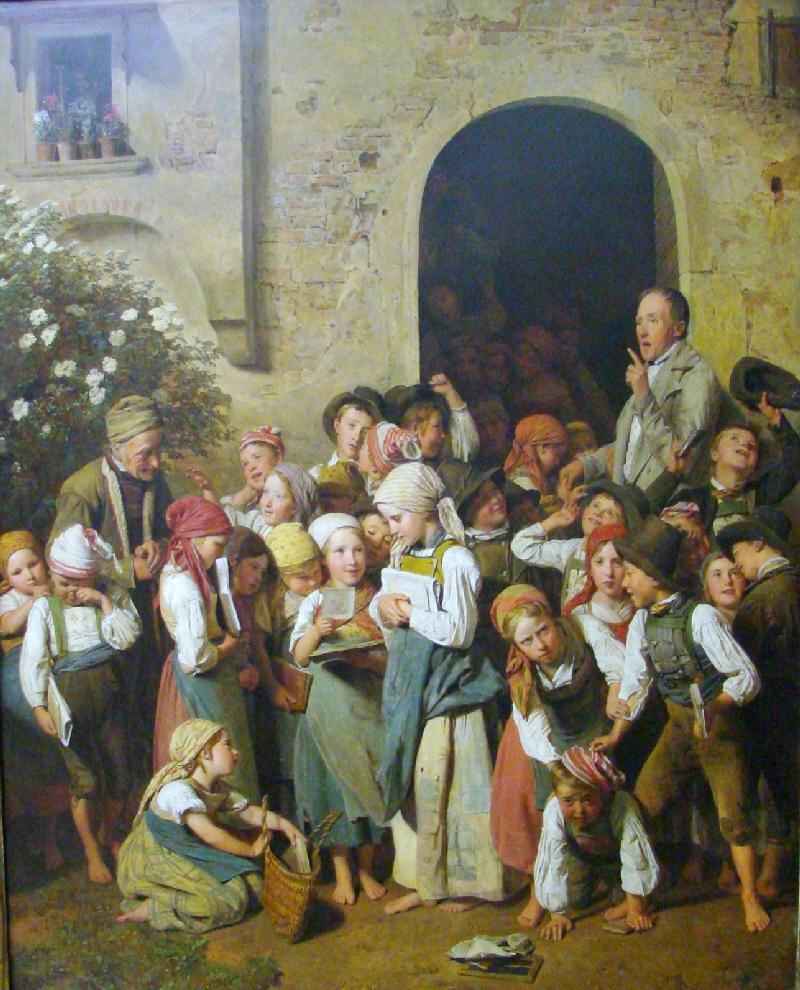
Austrian Empire: Education ( -1867)

Figure 1.--The Austrian painter Ferdinand Georg Waldmüller (1793-1865) painted this study of a rural Austrian school. He was professor at the Academy of Fine Arts in Vienna. He dis a notable painting of the great composer, Ludwig van Beethoven (1823). This painting was "Nach der Schule", i.e. "After school". It was painted in 1841. The school was a village school in rural Austria far from Vienna. The children wear their everyday clothing and all, boys and girls, go barefoot. Notice the girls wear scarves, but the boys all kinds of hzts and caps.
|
|
Austria came to dominate the Holy Roman Empire. Austria iyself was relatively small, but the Hapsburgs acquired non-German principalities, including Bohemia, Hungary, the Lowlands, and others. While Austria was not at first an empire, its dominnce wuthin the Holu Roman Empire resulted in the Archuke of Austria being routinely elected Holy Roman Emperor. The Protestant Revolution checke the Hapsburgs and Prussia began to emerge as a rival within the Holy Roman Empire. The secession fell upon Maria Theresa in the 18th century. She inherited the Austrian throne, but only me could be elected Holu Roman emperor so beginning wiyh Maria Theresa the Austriian archduke or in her case duchess began styling themselves emperor. Maria Theresa was a progressive ruler and instituted many reforms. The first compulsory school attendance law was introduced in Austria by Maria Theresa (1774). Other German states followed the Austrian example and Austria became a leader in pub;ic education. The same approach was not followed througout the Empire, especially in the areas controlled ny Hungarian nobels. We have little information on the clothes worn in early Austrian schools.
HBC has no information on what Austrian school boys were wearing in the early and mid-19th century. Austrian boys wore the common early 19tyh century styles of skeleton suits and tunics, but I do not know to what extent the styles were worn to school. I'm not sure just when began wearing lederhosen to school, other than as rural dress, probably the mid-19th century. About this time the sailor suit was imported and became quite popular. At the time the Austrian-Hungarian Empire had a small navy which it deployed in the Mediteranean.
HBC

Navigate the Boys' Historical Clothing Austrian pages:
[Return to the Main school uniform page]
[Austrian boys clothes]
[Austrian choirs]
[Lederhosen]
[Austrian choirs]
[Austrian royalty]
[Austrian military schools]
[Austrian families]
Navigate the Boys' Historical Clothing Web Site:
[Return to the Main Waldmüller page]
[Introduction]
[Activities]
[Biographies]
[Chronology]
[Clothing styles]
[Countries]
[Bibliographies]
[Contributions]
[FAQs]
[Glossaries]
[Images]
[Links]
[Registration]
[Tools]
[Boys' Clothing Home]
Navigate the Boys' Historical Clothing school uniform pages:
[Reyurn to the Main Austrian schoolmpage]
[Return to the Main national school uniform page]
[Australia]
[Belgium]
[England]
[France]
[Germany]
[Ireland]
[Italy]
[Japan]
[Korea]
[Mexico]
[New Zealand]
[Scotland]
[United States]
Created: 8:50 AM 1/25/2009
Last updated: 8:50 AM 1/25/2009




